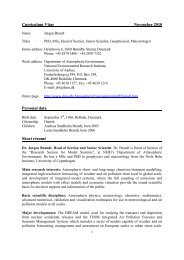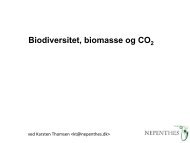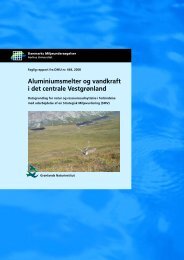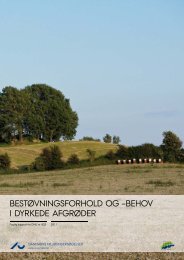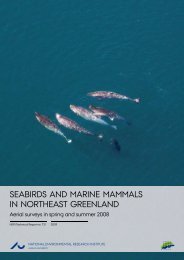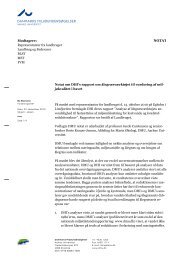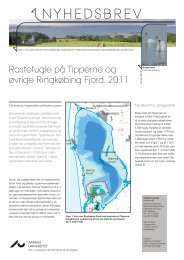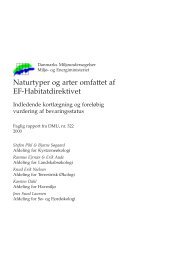Spatial distribution of emissions to air - the SPREAD model
Spatial distribution of emissions to air - the SPREAD model
Spatial distribution of emissions to air - the SPREAD model
You also want an ePaper? Increase the reach of your titles
YUMPU automatically turns print PDFs into web optimized ePapers that Google loves.
&RQFOXVLRQ<br />
The <strong>SPREAD</strong> <strong>model</strong> has been prepared as part <strong>of</strong> <strong>the</strong> emission inven<strong>to</strong>ry<br />
project at <strong>the</strong> National Environmental Research Institute, Aarhus University.<br />
<strong>SPREAD</strong> will be applied for <strong>the</strong> next manda<strong>to</strong>ry reporting <strong>of</strong><br />
gridded <strong>emissions</strong> <strong>to</strong> CLRTAP primo 2012.<br />
Former spatial <strong>distribution</strong>s have had a ra<strong>the</strong>r low resolution (50x50 km<br />
and 17x17 km) compared <strong>to</strong> <strong>the</strong> Danish area and are considered less useful<br />
for <strong>air</strong> quality <strong>model</strong>ling, health effect estimation and associated costbenefit<br />
analysis. As <strong>emissions</strong> in <strong>the</strong> national inven<strong>to</strong>ry in most cases are<br />
based on very detailed data and as <strong>the</strong> resulting <strong>emissions</strong> are considered<br />
<strong>to</strong> have small uncertainties, a high spatial resolution <strong>distribution</strong><br />
will improve <strong>the</strong> use <strong>of</strong> emission data in many contexts.<br />
To ensure that <strong>the</strong> spatial <strong>distribution</strong> reflect <strong>the</strong> degree <strong>of</strong> detail in <strong>the</strong><br />
inven<strong>to</strong>ry, <strong>the</strong> <strong>emissions</strong> are distributed on a highly disaggregated level.<br />
Therefore <strong>the</strong> <strong>SPREAD</strong> <strong>model</strong> is based on SNAP categories ra<strong>the</strong>r than<br />
<strong>the</strong> NFR and CRF categories used in <strong>the</strong> national emission reporting.<br />
This has lead <strong>to</strong> demand for setting up a larger number <strong>of</strong> <strong>distribution</strong><br />
keys.<br />
A large workload has been put in <strong>the</strong> <strong>distribution</strong> <strong>of</strong> <strong>emissions</strong> in <strong>the</strong> energy<br />
sec<strong>to</strong>r. The inven<strong>to</strong>ry system handles Large Point Sources and area<br />
sources, but as <strong>the</strong> calculations in <strong>the</strong> national inven<strong>to</strong>ry system include<br />
data from a large number <strong>of</strong> point sources, <strong>the</strong>se <strong>emissions</strong> are allocated<br />
on <strong>the</strong> site <strong>of</strong> each single plant. As this approach differ from <strong>the</strong> approach<br />
in <strong>the</strong> inven<strong>to</strong>ry system, much work has been done <strong>to</strong> re-allocate<br />
fuel consumptions on SNAP categories and <strong>to</strong> apply corrections <strong>to</strong> ensure<br />
that <strong>the</strong> <strong>emissions</strong> in <strong>the</strong> inven<strong>to</strong>ry and in <strong>the</strong> <strong>distribution</strong> are exactly<br />
<strong>the</strong> same.<br />
The <strong>distribution</strong> <strong>of</strong> <strong>emissions</strong> from agriculture is based on a complex bot<strong>to</strong>m-up<br />
approach including more very large and very detailed datasets.<br />
Emissions related <strong>to</strong> animals are based on information on all registered<br />
animals in Denmark and <strong>the</strong>reby it is possible <strong>to</strong> allocate <strong>the</strong> <strong>emissions</strong><br />
very accurately. Emissions related <strong>to</strong> soils and crops are calculated on<br />
field level in consideration <strong>of</strong> crop types and soil types, and this emission<br />
allocation is very accurate as well. As is <strong>the</strong> case for <strong>the</strong> energy sec<strong>to</strong>r,<br />
<strong>the</strong> emission calculation approach differs between <strong>the</strong> inven<strong>to</strong>ry system<br />
and <strong>the</strong> bot<strong>to</strong>m-up methodology, and <strong>the</strong> latter is corrected <strong>to</strong> make sure<br />
<strong>the</strong> <strong>emissions</strong> in <strong>the</strong> <strong>distribution</strong> and in <strong>the</strong> national emission inven<strong>to</strong>ry<br />
equal.<br />
A number <strong>of</strong> point sources have been geo-coded manually ei<strong>the</strong>r by use<br />
<strong>of</strong> <strong>the</strong> public Information Server (OIS) administrated by <strong>the</strong> Danish Enterprise<br />
and Construction Authority, where coordinates can be found via<br />
addresses, or via visual identification in Google Earth. Manual geocoding<br />
has been used for e.g. municipal solid waste disposals and waste<br />
water treatment plants.<br />
53





